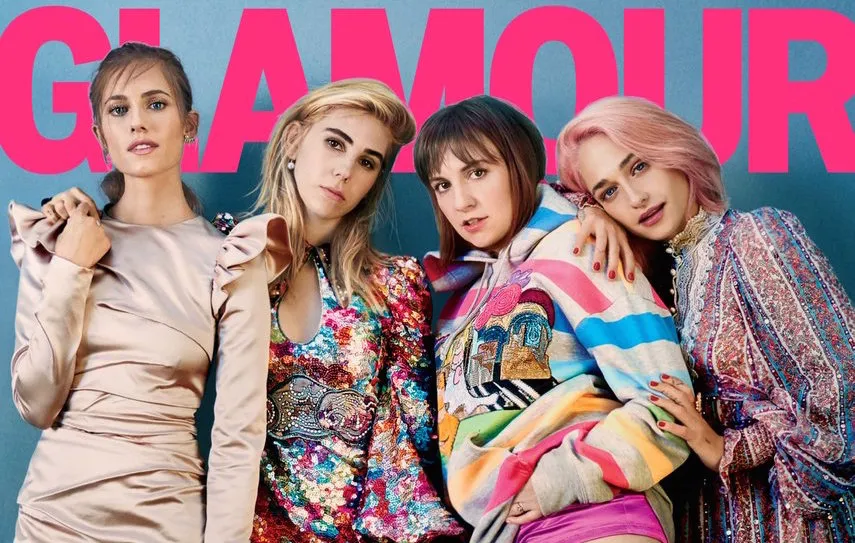In what so many of us wish weren’t a rarity, the February issue of Glamour is going Photoshop-free. Lena Dunham and the other women of Girls are featured in the cover story, and Dunham, who is no stranger to having her appearance criticized, took to Instagram to describe the experience of being a part of the issue.
Okay, here goes: throughout my teens I was told, in no uncertain terms, that I was fucking funny looking. Potbelly, rabbit teeth, knock knees- I could never seem to get it right and it haunted my every move. I posed as the sassy confident one, secretly horrified and hurt by careless comments and hostility. Let’s get something straight: I didn’t hate what I looked like- I hated the culture that was telling me to hate it. When my career started, some people celebrated my look but always through the lens of “isn’t she brave? Isn’t it such a bold move to show THAT body on TV?” Then there were the legions of trolls who made high school teasing look like a damned joke with the violent threats they heaped on, the sickening insults that made me ache for teen girls like me who might be reading my comments. Well, today this body is on the cover of a magazine that millions of women will read, without photoshop, my thigh on full imperfect display. Whether you agree with my politics, like my show or connect to what I do, it doesn’t matter- my body isn’t fair game. No one’s is, no matter their size, color, gender identity, and there’s a place for us all in popular culture to be recognized as beautiful. Haters are gonna have to get more intellectual and creative with their disses in 2017 because none of us are going to be scared into muumuus by faceless basement dwellers, or cruel blogs, or even our partners and friends. Thank you to the women in Hollywood (and on Instagram!) leading the way, inspiring and normalizing the female form in EVERY form, and thank you to @glamourmag for letting my cellulite do the damn thing on news stands everywhere today ❤️ Love you all.
As Dunham acknowledges, she’s a divisive figure. She’s said some things over the last few years that have driven away even Girls superfans. But way too many people are as put off by the way they view her body as by the way they view her words. And that’s where the problem with perpetuating that Photoshop ideal (which Dunham has had past troubles with) lies. “My body isn’t fair game” shouldn’t be something we have to say, but a woman’s worth is so inextricably tied to her appearance that this message—that a woman’s words are only worth listening to if you like watching her say them—too often gets lost.
To fully celebrate this pro-woman, real-woman issue of a women’s magazine, Glamour decided to hire only women to put it together. The magazine’s editor-in-chief Cindi Leive said that she was disappointed in her own publication’s hiring statistics. In their fall print issues last year, only 37% of the photographers were women. Only 32% of the magazine’s hairstylists were women. She also notes, “Forty-nine percent of makeup artists were female, but dismayingly the ratio got lower as the story got bigger.” (There’s no mention of statistics or goals related to race or any other potential factors in this kind of artistic hiring, which is disappointing.) In an email to USA Today, Leive talked about the decision to fill up 100% of those spots with women for one issue.
Gender equality is on all of our minds. It’s really important to me that Glamour not just talk the talk about female empowerment, but that we also walk the walk. So we’ve decided to support women in the most meaningful way we can: by hiring them. From first page to our last every photo we commissioned for the February issue was created by women: photographers, stylists, hair, makeup, everything.
There are still men featured prominently in the issue, though, the most notable being the designers. The powerful, unphotoshopped women on the cover are all dressed in clothing by Marc Jacobs.
Our first cover as a fearsome foursome. Can’t wait to show the grandkids ❤️❤️❤️ Love you @glamourmag! https://t.co/MOVll3svXPpic.twitter.com/gFvD5QFPTN
— Lena Dunham (@lenadunham) January 3, 2017
Leive explained her reasoning there:
“For this issue we focused on our hiring,” Leive explained. “We wanted to ensure that everybody we employed for the issue content was female.”
“Our female contributors were then given free rein to choose whatever fashion items they liked,” she continued, “which included in this story, not just Marc Jacobs but also Prada and Fenty,” both of which are helmed by female designers.
That makes total sense, but if Leive wanted both the action and the symbolism of hiring 100% women, asking those women to also hire women for this one specific shoot doesn’t seem like that out-there of a request. Especially since in the issue’s opening letter, she quotes historian Valerie Steele on why men dominate the fashion industry, saying there is a prevailing (and demeaning) view that “women are too close to it; they can only dress themselves. Men are the artists.”
It’s awesome that women filled up the roles both behind and in front of the cameras in this issue. But it seems like still having that male-created “art” on the cover of a fashion magazine—in this one issue; no one’s saying men’s work shouldn’t be on the cover of other months’ issues—is a missed opportunity to fully reach the magazine’s goal.
(via Mediaite, image via Twitter)
—The Mary Sue has a strict comment policy that forbids, but is not limited to, personal insults toward anyone, hate speech, and trolling.—
Follow The Mary Sue on Twitter, Facebook, Tumblr, Pinterest, & Google+.










Published: Jan 4, 2017 06:09 pm